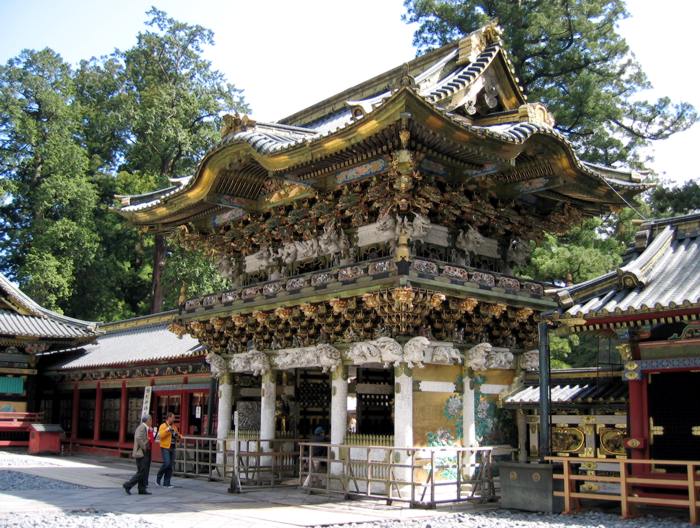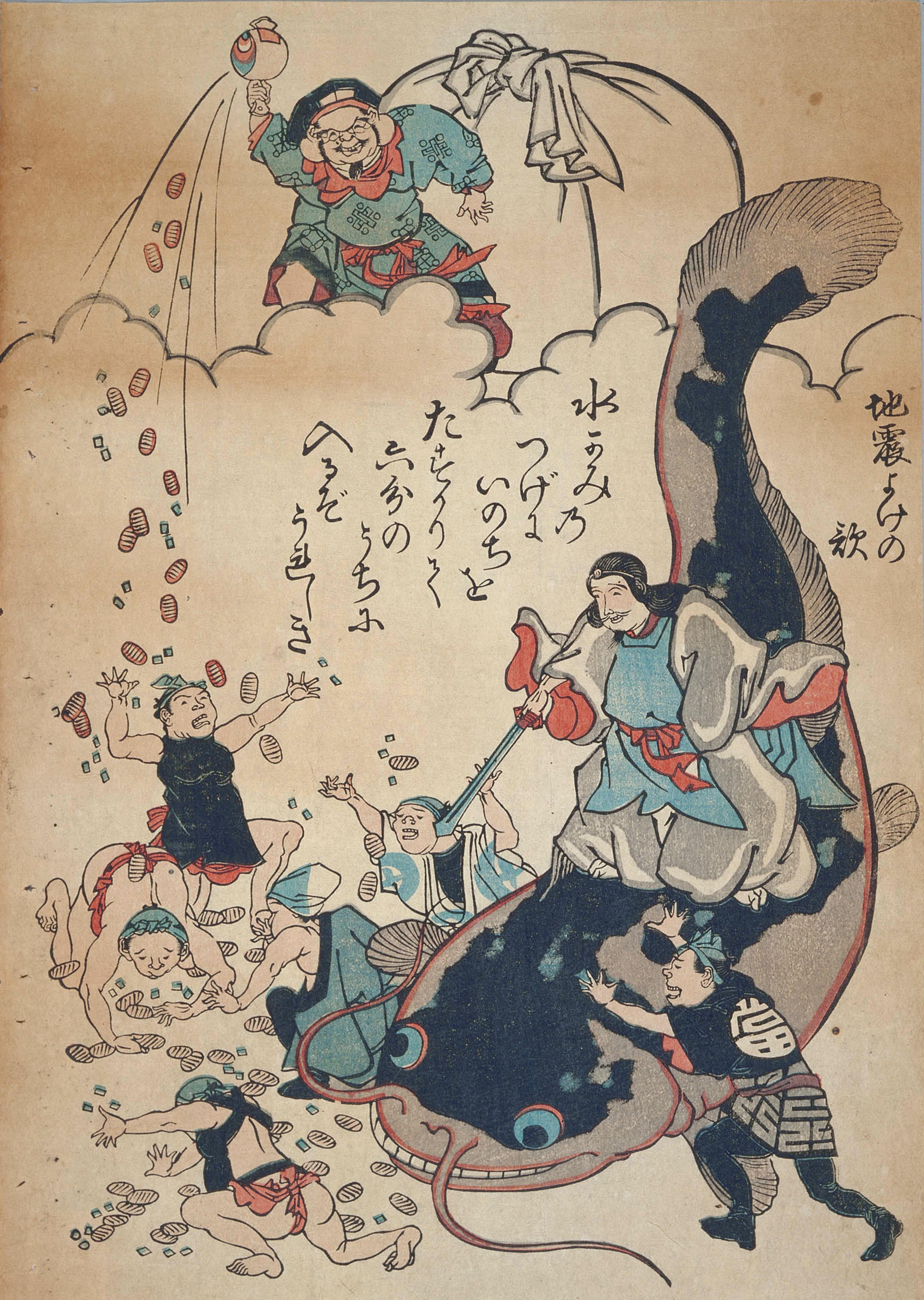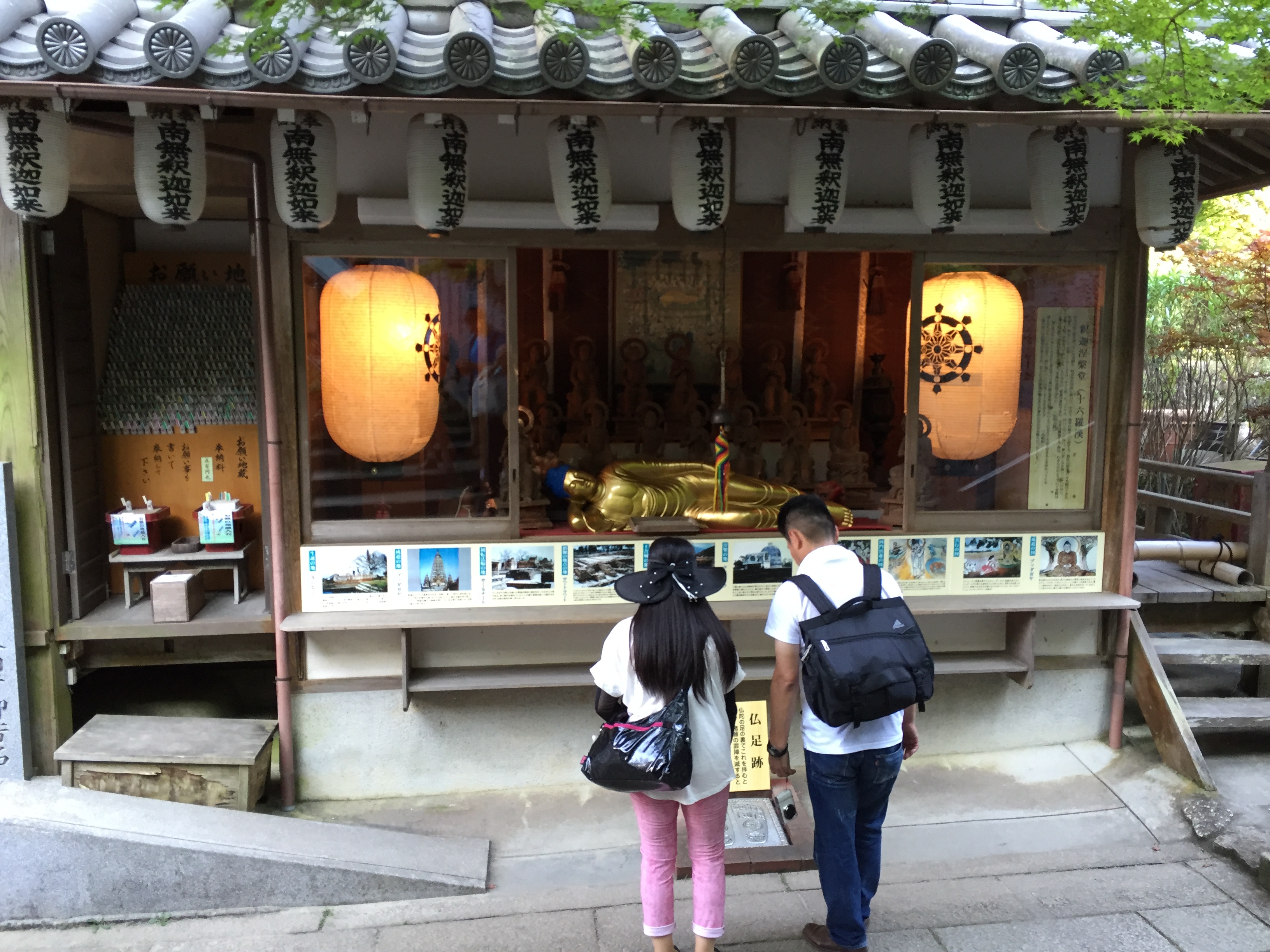|
Myōjin
Myōjin (明神 'shining deity', 'illuminating deity', or 'apparent deity') or Daimyōjin (大明神 'great shining/apparent deity') was a title historically applied to Japanese (Shinto) deities (''kami'') and, by metonymy, their shrines. The term is thought to have been derived from ''myōjin'' (名神 'notable deity'), a title once granted by the imperial court to ''kami'' deemed to have particularly impressive power and virtue and/or have eminent, well-established shrines and cults. This term is first attested in the '' Shoku Nihongi'', where offerings from the kingdom of Bohai (Balhae) are stated to have been offered to "the eminent shrines (名神社 ''myōjin-sha'') in each province" in the year 730 ( Tenpyō 2). An epithet homophonous with this imperially bestowed title, "shining/apparent ''kami''" (written with different Chinese characters), was in popular usage from around the Heian period up until the end of the Edo period, coexisting with titles with more explicit Bu ... [...More Info...] [...Related Items...] OR: [Wikipedia] [Google] [Baidu] |
Takeminakata
Takeminakata (タケミナカタ), also known as Minakatatomi or Takeminakatatomi, is a ''kami'' in Japanese mythology. Also known as or after Suwa Grand Shrine (Suwa Taisha) in Nagano Prefecture (former Shinano Province) in which he is enshrined alongside his consort Yasakatome, Takeminakata is historically worshiped as a god of wind, water and agriculture, as well as a patron of hunting and warfare, in which capacity he enjoyed a particularly fervent cult from various samurai clans during the medieval period such as the Hōjō or the Takeda. Takeminakata was also held to be the mythical ancestor of certain families who once served at the shrine as priests, foremost among them being the Suwa clan, the high priests of the Upper Shrine of Suwa who were also revered as living vessels of the god. Whereas in the '' Kojiki'' (ca. 712 CE) and later derivative accounts, Takeminakata appears as one of the sons of the god Ōkuninushi who fled to Lake Suwa after being defeated by t ... [...More Info...] [...Related Items...] OR: [Wikipedia] [Google] [Baidu] |
Suwa Taisha
, historically also known as Suwa Shrine (諏訪神社 ''Suwa-jinja'') or , is a group of Shinto shrines in Nagano Prefecture, Japan. The shrine complex is the ''ichinomiya'' of former Shinano Province and is considered to be one of the oldest shrines in existence, being implied by the '' Nihon Shoki'' to already stand in the late 7th century. Kanpei-taisha Overview The entire Suwa shrine complex consists of four main shrines grouped into two sites: the Upper Shrine or ''Kamisha'' (上社), comprising the and the , and the Lower Shrine or ''Shimosha'' (下社), comprising the ''Harumiya'' (春宮, spring shrine) and the ''Akimiya'' (秋宮, autumn shrine). The Upper Shrine is located on the south side of Lake Suwa, in the cities of Chino and Suwa, while the Lower Shrine is on the northern side of the lake, in the town of Shimosuwa. In addition to these four main shrines, some sixty other auxiliary shrines scattered throughout the Lake Suwa area (ranging from miniature stone ... [...More Info...] [...Related Items...] OR: [Wikipedia] [Google] [Baidu] |
Shinto Shrine
A is a structure whose main purpose is to house ("enshrine") one or more ''kami'', the deities of the Shinto religion. Overview Structurally, a Shinto shrine typically comprises several buildings. The '' honden''Also called (本殿, meaning: "main hall") is where a shrine's patron ''kami'' is/are enshrined.Iwanami Japanese dictionary The ''honden'' may be absent in cases where a shrine stands on or near a sacred mountain, tree, or other object which can be worshipped directly or in cases where a shrine possesses either an altar-like structure, called a ''himorogi,'' or an object believed to be capable of attracting spirits, called a ''yorishiro,'' which can also serve as direct bonds to a ''kami''. There may be a and other structures as well. Although only one word ("shrine") is used in English, in Japanese, Shinto shrines may carry any one of many different, non-equivalent names like ''gongen'', ''-gū'', ''jinja'', ''jingū'', ''mori'', ''myōjin'', ''-sha'', ''taisha ... [...More Info...] [...Related Items...] OR: [Wikipedia] [Google] [Baidu] |
Gongen
A , literally "incarnation", was believed to be the manifestation of a buddha in the form of an indigenous kami, an entity who had come to guide the people to salvation, during the era of shinbutsu-shūgō in premodern Japan.Encyclopedia of Shinto''Gongen''accessed on October 5, 2008Tamura (2000:87) The words and are synonyms for gongen. is the term for belief in the existence of gongen. The gongen concept is the cornerstone of the honji suijaku theory, according to which Buddhist deities choose to appear to the Japanese as native kami in order to save them, which is based on the Mahayana Buddhist notion of upaya, "expedient means". History It is sometimes assumed that the word ''gongen'' derives from Tokugawa Ieyasu's posthumous name (Tōshō Daigongen). However, the term was created and started being used in the middle of the Heian period in an effort to harmonize Buddhism and indigenous religious practice in what is called shinbutsu-shūgō or "syncretism of kami and bud ... [...More Info...] [...Related Items...] OR: [Wikipedia] [Google] [Baidu] |
Shinto
Shinto () is a religion from Japan. Classified as an East Asian religion by scholars of religion, its practitioners often regard it as Japan's indigenous religion and as a nature religion. Scholars sometimes call its practitioners ''Shintoists'', although adherents rarely use that term themselves. There is no central authority in control of Shinto, with much diversity of belief and practice evident among practitioners. A polytheistic and animistic religion, Shinto revolves around supernatural entities called the . The are believed to inhabit all things, including forces of nature and prominent landscape locations. The are worshiped at household shrines, family shrines, and ''jinja'' public shrines. The latter are staffed by priests, known as , who oversee offerings of food and drink to the specific enshrined at that location. This is done to cultivate harmony between humans and and to solicit the latter's blessing. Other common rituals include the dances, rites of pass ... [...More Info...] [...Related Items...] OR: [Wikipedia] [Google] [Baidu] |
Sumiyoshi Sanjin
is the generic name for the three Shinto gods ''Sokotsutsu no O no Mikoto'' (底筒男命), ''Nakatsutsu no O no Mikoto'' (中筒男命), and ''Uwatsutsu no O no Mikoto'' (表筒男命). The Sumiyoshi sanjin are regarded as the gods of the sea and sailing. They are sometimes referred to as the . The Sumiyoshi taisha has four buildings dedicated to four ''kami''—the three Sumiyoshi brothers and Empress Jingū who is also enshrined.Nussbaum, Louis-Frédéric. (2005). "Sumiyoshi taisha (or 'jinja)" in . According to Japanese mythology as written in works such as the Kojiki and Nihon Shoki, the Sumiyoshi sanjin were born together with the Watatsumi Sanjin (綿津見三神) when Izanagi performed a purification ceremony after returning from Yomi. Originally the Sumiyoshi sanjin and Watasumi sanjin were the same gods, but when, in ancient times, the throne was moved east from Kyūshū to the area now known as Kinki, it was the Sumiyoshi sanjin that supposedly served an important rol ... [...More Info...] [...Related Items...] OR: [Wikipedia] [Google] [Baidu] |
Hachiman
In Japanese religion, ''Yahata'' (八幡神, ancient Shinto pronunciation) formerly in Shinto and later commonly known as Hachiman (八幡神, Japanese Buddhist pronunciation) is the syncretic divinity of archery and war, incorporating elements from both Shinto and Buddhism. In Shinto religion, he is mortally Emperor Ōjin (応神天皇, ''Ōjin Tennō'') by birth who reigned in the 3rd–4th century and the son of Empress Jingū (神功皇后, ''Jingū-kōgō''), later became deified and identified by legend as "''Yahata-no-kami''" meaning "Kami of Eight Banners", referring to the eight heavenly banners that signaled the birth of the divine and deified emperor, and is also called ''Hondawake'' (誉田別命). His messenger is the dove, symbolizes both the bow and arrow found in samurai banners associated to him where he is called "''Yumiya Hachiman''" (弓矢八幡). Since ancient times Hachiman has been worshiped by farmers as the god of agriculture and by fishermen, who hoped ... [...More Info...] [...Related Items...] OR: [Wikipedia] [Google] [Baidu] |
Kashima Shrine
is a Shinto shrine located in Kashima, Ibaraki in the northern Kantō region of Japan. It is dedicated to , one of the patron deities of martial arts. Various dōjō of ''kenjutsu'' and ''kendō'' often display a hanging scroll emblazoned with the name "Takemikazuchi-no-Ōkami". Prior to World War II, the shrine was ranked as one of the three most important imperial shrines in the Shinto hierarchy, along with Ise Grand Shrine (伊勢神宮 ''Ise Jingū'') and Katori Shrine (香取神宮 ''Katori Jingū''). During the New Year period, from the first to the third of January, Kashima Shrine is visited by over 600,000 people from all over Japan. It is the second most visited shrine in Ibaraki prefecture for new year pilgrims. Introduction Kashima Shrine is located at the top of the Kashima plateau in south-east Ibaraki Prefecture, intersecting Lake Kitaura and Kashima Bay and in close proximity to Katori Shrine, which also has a strong connection to the martial arts. The shrine ... [...More Info...] [...Related Items...] OR: [Wikipedia] [Google] [Baidu] |
Takemikazuchi
is a deity in Japanese mythology, considered a god of thunder and a sword god. He also competed in what is considered the first sumo wrestling match recorded in history. He is otherwise known as "The ''kami'' of Kashima"" (Kashima-no-kami), the chief deity revered in the Kashima Shrine at Kashima, Ibaraki (and all other subsidiary Kashima shrines). In the ''namazu-e'' or catfish pictures of the Edo period, Takemikazuchi/Kashima is depicted attempting to subdue the giant catfish supposedly dwelling at the of the Japanese landmass and causing its earthquakes. Forms of the name In the ''Kojiki'', the god is known as Takemikazuchi-no-o no kami (建御雷之男神 – "Brave Mighty Thunderbolt Man").Heldt, Gustav. ''The Kojiki: An Account of Ancient Matters''. Columbia University Press, 2014. He also bears the alternate names and .『古事記』text p. 27/ mod. Ja. tr. p.213 Birth of the gods In the Kamiumi ("birth of the gods") episodes of the ''Kojiki'', the god of creation I ... [...More Info...] [...Related Items...] OR: [Wikipedia] [Google] [Baidu] |
Three Ages Of Buddhism
The Three Ages of Buddhism, also known as the Three Ages of the Dharma (), are three divisions of time following Shakyamuni Buddha's death and passing into Nirvana in East Asian Buddhism. Three Ages The Three Ages of Buddhism are three divisions of time following Buddha's passing: # Former Day of the Dharma — also known as the “Age of the Right Dharma” (; Japanese: shōbō), the first thousand years (or 500 years) during which the Buddha's disciples are able to uphold the Buddha's teachings; # Middle Day of the Dharma — also known as the “Age of Semblance Dharma” (; Japanese: zōhō), the second thousand years (or 500 years), which only resembles the right Dharma; # Latter Day of the Dharma — also known as “the Degenerate Age of Dharma” (; Japanese: mappō), which is to last for 10,000 years during which the Dharma declines. In the Sutra of the Great Assembly (Sanskrit: ''Maha-Samnipata Sutra''; Japanese: ''Daijuku-kyō''), the three periods are further d ... [...More Info...] [...Related Items...] OR: [Wikipedia] [Google] [Baidu] |
Parinirvana
In Buddhism, ''parinirvana'' (Sanskrit: '; Pali: ') is commonly used to refer to nirvana-after-death, which occurs upon the death of someone who has attained ''nirvana'' during their lifetime. It implies a release from '' '', karma and rebirth as well as the dissolution of the ''skandhas''. In some Mahāyāna scriptures, notably the ''Mahāyāna Mahāparinirvāṇa Sūtra'', ''parinirvāṇa'' is described as the realm of the eternal true Self of the Buddha. In the Buddha in art, the event is represented by a reclining Buddha figure, often surrounded by disciples. Nirvana after death In the Buddhist view, when ordinary people die, each person's unresolved karma passes on to a new birth instantaneously; and thus the karmic inheritance is reborn in one of the six realms of '' samsara''. However, when a person attains nirvana, they are liberated from karmic rebirth. When such a person dies, it is the end of the cycle of rebirth, the Samsara and the Karma. Contemporary scholar Ru ... [...More Info...] [...Related Items...] OR: [Wikipedia] [Google] [Baidu] |
Sutra
''Sutra'' ( sa, सूत्र, translit=sūtra, translit-std=IAST, translation=string, thread)Monier Williams, ''Sanskrit English Dictionary'', Oxford University Press, Entry fo''sutra'' page 1241 in Indian literary traditions refers to an aphorism or a collection of aphorisms in the form of a manual or, more broadly, a condensed manual or text. Sutras are a genre of ancient and medieval Indian texts found in Hinduism, Buddhism and Jainism. In Hinduism, sutras are a distinct type of literary composition, a compilation of short aphoristic statements.Gavin Flood (1996), ''An Introduction to Hinduism'', Cambridge University Press, , pages 54–55 Each sutra is any short rule, like a theorem distilled into few words or syllables, around which teachings of ritual, philosophy, grammar, or any field of knowledge can be woven. The oldest sutras of Hinduism are found in the Brahmana and Aranyaka layers of the Vedas. Every school of Hindu philosophy, Vedic guides for rites of passage, v ... [...More Info...] [...Related Items...] OR: [Wikipedia] [Google] [Baidu] |










